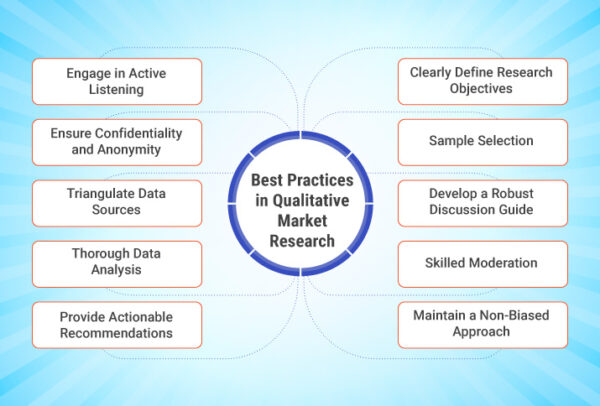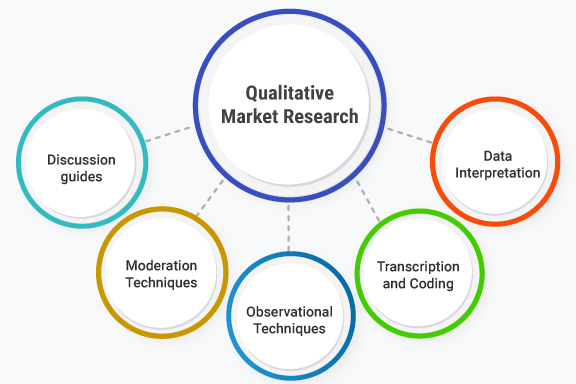Table of Contents
What is Qualitative Market Research?
Qualitative market research is defined as a systematic and open-ended market research method used to gain an understanding of consumer behavior, perceptions, preferences, and motivations.
It involves the collection and analysis of non-numerical data from research respondents to uncover rich insights that quantitative market research methods may not capture. Qualitative market research provides a deeper exploration of consumer experiences, allowing businesses to make informed decisions and tailor their marketing efforts to specific target audiences.
Market research plays a crucial role in understanding consumers, market trends, and the competitive landscape. While quantitative market research focuses on numerical data and statistical analysis, qualitative market research offers valuable insights into the attitudes, motivations, and behaviors of consumers.
In this article, we will explore the definition of qualitative market research, its types, methods, and best practices. Understanding the fundamentals of qualitative market research will empower businesses to make informed decisions and develop effective marketing strategies.
Key Components of a Qualitative Market Research Study
Qualitative market research employs several methods to collect and analyze data. These methods include:
- Discussion guides: Discussion guides act as a framework for conducting focus groups or interviews. They include a series of open-ended questions designed to explore specific topics or areas of interest.
- Moderation Techniques: Effective moderation is crucial in qualitative market research. Skilled moderators facilitate discussions, encourage participation, manage group dynamics, and ensure that all participants have the opportunity to express their opinions.
- Observational Techniques: Observational techniques involve researchers observing and documenting consumer behaviors, interactions, and environments. This method provides valuable insights into how consumers engage with products, brands, or retail spaces.
- Transcription and Coding: After data collection, researchers transcribe interviews or group discussions verbatim. Transcripts are then coded, categorizing data into themes or concepts to identify patterns, trends, and key findings.
- Data Interpretation: Data interpretation involves analyzing and synthesizing qualitative data to draw meaningful conclusions and actionable insights. Researchers identify emerging themes, explore connections, and generate a holistic understanding of consumer attitudes and behaviors.
Learn more: What is Qualitative Observation?
Types of Qualitative Market Research Methods

Qualitative market research encompasses various types, each serving different purposes in understanding consumers and the market. Some common types of qualitative market research include:
- Focus Groups
Focus groups involve small groups of individuals (usually 6-10 participants) who are brought together to discuss a specific product, service, or marketing concept. A skilled moderator guides the discussion, allowing participants to share their thoughts, opinions, and experiences. Focus groups enable researchers to explore a range of perspectives and uncover underlying motivations and attitudes. They are often used to test new product ideas, evaluate advertising campaigns, or gather feedback on existing products or services.
For example, a political focus group may select a sample of 5 distinct people from a specific election neighborhood to probe them on their preferences and responses to election issues. The goal here typically is to understand which issues ring the loudest with voters enough to make them want to vote for a specific political party.
- In-depth Interviews
In-depth interviews are one-on-one conversations between a researcher and a participant. This method allows for in-depth exploration of individuals’ thoughts, emotions, and decision-making processes. Researchers can ask probing questions and delve into specific topics of interest. In-depth interviews are particularly useful for understanding complex purchasing decisions, exploring customer experiences, or uncovering underlying motivations and preferences.
- Ethnography and Observational Research
Ethnographic and observational research involves observing consumers in their natural environments, such as their homes, workplaces, or stores. Researchers immerse themselves in the consumers’ context, observing behaviors, interactions, and decision-making processes. This approach provides valuable insights into how customers use products, navigate retail spaces, or engage with brands. Ethnographic research can uncover hidden needs, barriers to adoption, and opportunities for improvement.
- Online Communities and Forums
Online communities and forums offer a platform for engaging with customers in a virtual setting. Researchers can create private communities where participants can share their opinions, provide feedback, or engage in discussions over an extended period. This method allows for ongoing interactions, asynchronous discussions, and the exploration of various topics. Online communities are valuable for gathering insights into customer experiences, testing product concepts, or generating new ideas.
For example, a company may be using a tool like Ideascale to onboard customers onto an online community of product users with the goal of probing them on product feedback and satisfaction. Such a method allows respondents to be easily reachable via the real-time online portal, allowing room for extended and detailed probing of customer attitudes towards their products or services.
- Online Open-ended Surveys
While surveys are often associated with quantitative research, open-ended questions in surveys can provide qualitative insights. By allowing respondents to express their thoughts in their own words, researchers can capture detailed feedback, opinions, and suggestions. Open-ended survey questions can be used to explore customers’ perceptions, preferences, or experiences in a structured manner.
- Usability Testing
Usability testing focuses on evaluating the usability and user experience of products or websites. Participants are observed while they interact with a product or website, and researchers collect data on their behavior, frustrations, and preferences. Usability testing can uncover areas of improvement, identify usability issues, and provide insights into how customers engage with a product or website.
- Mystery Shopping
Mystery shopping involves sending researchers (known as mystery shoppers) to pose as customers and evaluate the customer experience at retail locations, service providers, or restaurants. Mystery shoppers follow a predefined scenario and report on various aspects, such as employee behavior, store ambiance, product availability, or service quality. This method provides firsthand insights into the customer experience and helps identify strengths and weaknesses in the customer journey.
- Social Media Listening and Analysis
Social media listening involves monitoring and analyzing conversations, mentions, and trends on social media platforms. Conducting qualitative research Researchers can gather qualitative data from social media by analyzing user-generated content, such as comments, reviews, or posts. Social media listening can uncover sentiment analysis, emerging trends, and customer perceptions about brands, products, or competitors.
It is worth noting that these qualitative market research methodologies can be used individually or in combination, depending on the research objectives and the target audience. Additionally, researchers often employ techniques like coding, thematic analysis, and content analysis to analyze and interpret qualitative data effectively.
Learn more: What is Customer Experience (CX) Research?
Advantages and Limitations of Qualitative Market Research
Qualitative market research offers several advantages and limitations that researchers and businesses should consider when designing research studies. Understanding these advantages and limitations is crucial for making informed decisions about when and how to use qualitative research methods. In this response, I will outline the key advantages and limitations of qualitative market research.
Advantages of Qualitative Market Research:
- In-depth Understanding: Qualitative market research allows for a detailed exploration of consumer behaviors, attitudes, and motivations. It provides rich, nuanced insights into why consumers make certain choices, how they perceive products or brands, and what factors influence their decision-making processes. This depth of understanding can inform the development of targeted marketing strategies and help businesses address specific customer needs.
- Contextual Insights: Qualitative research methods, such as ethnography and observational research, provide the opportunity to study consumers in their natural environments. This contextual understanding helps researchers identify contextual factors, social dynamics, and environmental influences that shape consumer behavior. By observing consumers in real-life settings, researchers can uncover valuable insights that may be missed in controlled laboratory or survey-based studies.
- Flexibility and Adaptability: Qualitative research methods offer flexibility in terms of study design and data collection techniques. Researchers can adapt their approach based on emerging findings, allowing for iterative and exploratory research. The dynamic nature of qualitative research enables researchers to delve deeper into emerging themes or explore new research questions that arise during the study, providing greater flexibility compared to more structured quantitative research methods.
- Participant Engagement: Qualitative research methods, such as focus groups and in-depth interviews, facilitate direct engagement with participants. This engagement fosters a sense of involvement and allows participants to express their opinions, perspectives, and experiences. The interactive nature of qualitative research methods can generate rich and diverse data, capturing a range of viewpoints and insights.
- Holistic View of the Customer Journey: Qualitative market research allows researchers to study the customer journey comprehensively. By exploring pre-purchase behaviors, decision-making processes, and post-purchase experiences, qualitative research provides a holistic view of the customer journey. This understanding helps businesses identify pain points, moments of delight, and opportunities for improvement throughout the entire customer experience.
Limitations of Qualitative Market Research:
- Limited Generalizability: Qualitative research typically involves a smaller sample size compared to quantitative research methods. While qualitative studies aim to provide in-depth insights, the findings may not be statistically representative of the larger population. The focus on depth and context may limit the ability to generalize the findings to the broader market. However, qualitative research can provide valuable insights into specific target groups or segments.
- Subjectivity and Bias: Qualitative market research relies on the interpretations and judgments of researchers and participants, introducing the potential for subjectivity and bias. The researcher’s personal biases, preconceptions, or interpretations may influence data collection, analysis, and reporting. Additionally, participants’ responses may be influenced by social desirability bias or other factors that impact their willingness to share certain opinions or experiences.
- Time and Resource Intensiveness: Qualitative research methods often require more time and resources compared to quantitative methods. The data collection process can be time-consuming, especially when conducting in-depth interviews or ethnographic research.
Best Practices in Qualitative Market Research

To ensure the reliability and validity of qualitative market research, several best practices should be followed:
1. Clearly Define Research Objectives: Clearly articulate the research objectives and questions to guide the study. Well-defined objectives help maintain focus and ensure that the research addresses specific business needs or marketing challenges.
2. Sample Selection: Thoughtful and representative sampling is essential in qualitative market research. Carefully select participants that represent your target market or audience. Aim for diversity in terms of demographics, behaviors, and attitudes to capture a comprehensive understanding of your consumer base.
3. Develop a Robust Discussion Guide: Prepare a well-structured discussion guide that includes open-ended questions to encourage participants to share their thoughts, opinions, and experiences. A comprehensive guide ensures consistency across interviews or focus groups.
4. Skilled Moderation: Choose experienced moderators who possess strong facilitation skills. Skilled moderators create an inclusive and comfortable environment, encourage participation, and effectively manage group dynamics to elicit valuable insights.
5. Maintain a Non-Biased Approach: Maintain an objective and neutral stance throughout the research process. Researchers should avoid leading questions, personal biases, or assumptions that may influence participant responses and skew the findings.
6. Engage in Active Listening: Practice active listening during interviews or focus groups. Pay attention to participants’ verbal and non-verbal cues, allowing for deeper exploration and follow-up questions to uncover valuable insights.
7. Ensure Confidentiality and Anonymity: Assure participants that their responses will remain confidential and anonymous. This promotes honesty and openness, leading to more authentic and insightful responses.
8. Thorough Data Analysis: Dedicate sufficient time and effort to analyze and interpret the qualitative data collected. Use rigorous coding techniques to identify patterns, themes, and emerging insights. Maintain an iterative approach to refine findings and uncover new perspectives.
9. Triangulate Data Sources: Combine multiple data sources and methods to triangulate findings and validate the research outcomes. Utilize techniques such as observations, interviews, and document analysis to gain a comprehensive understanding of consumer behavior.
10. Provide Actionable Recommendations: Translate research findings into actionable recommendations for your business or marketing strategies. Present key insights in a clear and concise manner, linking them directly to business objectives and decision-making processes.
By following these best practices, qualitative market researchers can conduct insightful and impactful studies that provide valuable insights for business growth and success.
Learn more: What is Quantitative Market Research?
Most Recent Blogs
Explore the latest innovation insights and trends with our recent blog posts.










